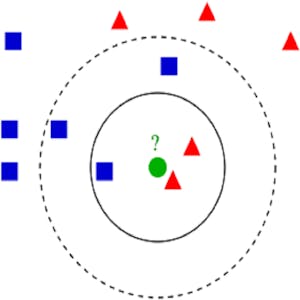Simple Nearest Neighbors Regression and Classification
University/Institute: Coursera Project Network

Description
In this 2-hour long project-based course, we will explore the basic principles behind the K-Nearest Neighbors algorithm, as well as learn how to implement KNN for decision making in Python. A simple, easy-to-implement supervised machine learning algorithm that can be used to solve both classification and regression problems is the k-nearest neighbors (KNN) algorithm. The fundamental principle is that you enter a known data set, add an unknown data point, and the algorithm will tell you which class corresponds to that unknown data point. The unknown is characterized by a straightforward neighborly vote, where the "winner" class is the class of near neighbors. It is most commonly used for predictive decision-making. For instance,: Is a consumer going to default on a loan or not? Will the company make a profit? Should we extend into a certain sector of the market? Note: This course works best for learners who are based in the North America region. We’re currently working on providing the same experience in other regions.